The 10th Monaco Energy Boat Challenge
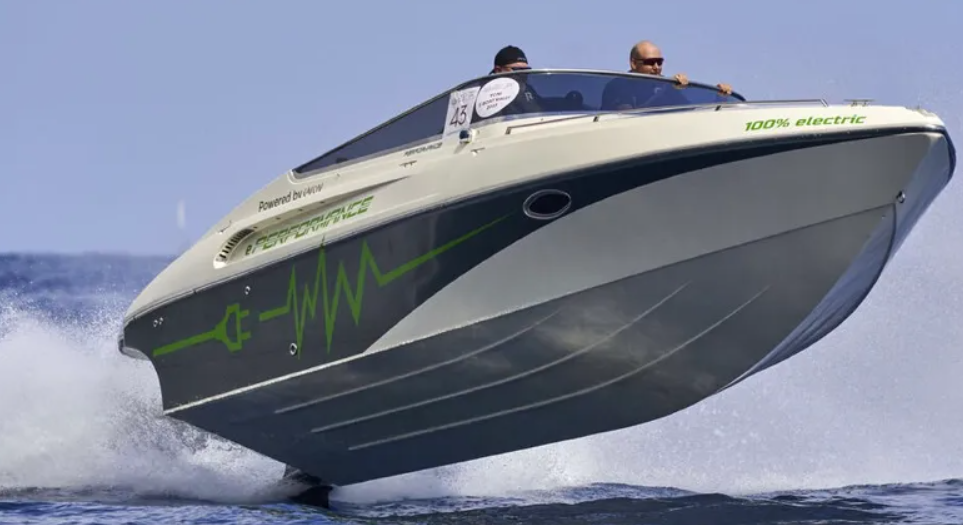
By Jeff Butler
Inspiring. That is the one word I would use – if forced to use only one word – to describe the four days of the 10th Monaco Energy Boat Challenge held July 5-8 at the Yacht Club de Monaco. Exciting, extraordinary, wildly impressive and other adjectives would all fit, but the most apt seems to be inspiring.
The MEBC is all about building a cleaner and better future for our waters, and everyone participating in the event – as founder, organizer, competitor, participant or spectator – would have been hard pressed not to come away with an optimistic outlook of what the best minds in marine propulsion are going to achieve in the years ahead.
On a personal level, seeing the Monaco event in a twitter feed in 2017 is what inspired me to find out more about electric boats and to start Plugboats. At that time only solar boats were in the competition, and university teams from 8 countries participated.
More than 50 electric boats of all shapes and sizes
In 2018 the emerging electric boat industry was added to the program and was represented by three boat manufacturers: the Cantieri Ernesto Riva with a beautifully crafted wooden electric boat (the e-Commuter, which won a Gussies Award in 2021), SAY Carbon – at that time the holder of the world electric boat speed record – and Vita Yachts, with the prototype of its first electric boat, the Vita IX.
That was also the year the Yacht Club added the Energy Class, in which the YCM supplies the student teams with the same design catamaran hull, and each team adds their own cockpit and propulsion system powered by renewable alternative energy sources.
Now, just five years later, more than 50 electric boats gathered in Monaco. Twenty eight were created by university teams from Europe, India, Indonesia and North and South America. Eight of those use hydrogen in their propulsion systems, and there were 22 more commercially available e-boats, most of which in 2018 were in their builders’ heads, on the drawing board or in financial ‘pitch decks’.
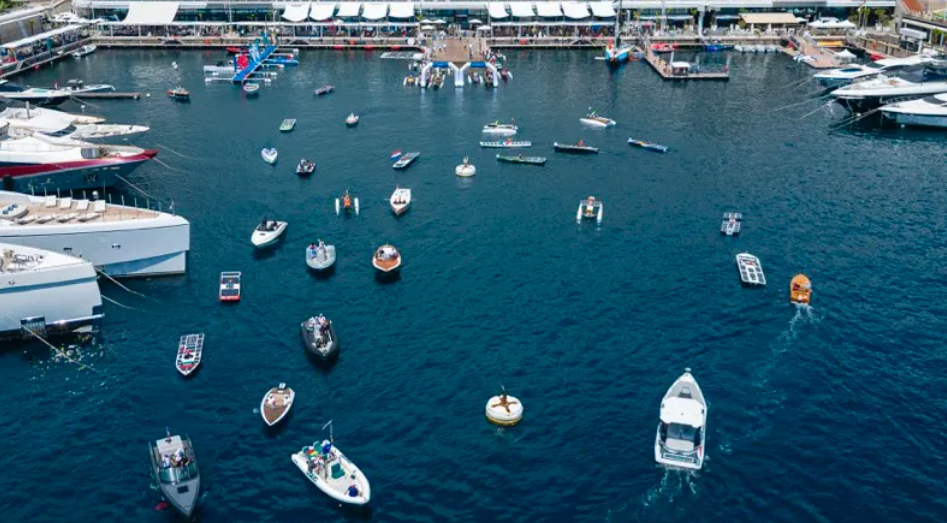
Vita Yachts brought four e-boats themselves to this year’s event – and affiliated company Aqua superPower assembled the YCM E-Dock at one end of the Yacht Club paddocks, rigged out with 10 marine fast chargers, each capable of servicing two boats at a time, to keep all of them ready to go at every moment.
Throughout the four days of the MEBC, there were many memorable moments, like a come-from-behind victory by the National Technical University of Athens in the Energy Class and a back and forth best-of-three match up in the Solar Class final between the wildly entertaining HAN Solarboat pilot and the calm captain of the Sunflare Solar entry.
For me, though, the symbol of the week was the sight of all of these electric boats, in all shapes and sizes, from students and manufacturers, circling around the waters in front of the Yacht Club de Monaco for the Parade that officially launched this 10th anniversary.
Strong support from the beginning
One of the people most impressed and excited about the turnout was Jérémie Lagarrigue of hydrogen pioneer EODev. He was there at the beginning of the MEBC in 2014 and was this year’s President of the Jury and Head of the Technical Committee for the Energy Class competitions.
He spoke of how YCM Secretary General Bernard Allessandri had been tremendously supportive from the start, embracing the idea of exploring new propulsion alternatives as a way to help protect and save the oceans. He immediately recognized that a new era of yachting and boating was dawning and a solar/electric boating event was a chance to continue to demonstrate the Club’s role as a leader in all aspects of yachting.
M. Alessandri is still leading the charge and could be seen throughout the week encouraging student competitors, chatting with industry executives, opening the Hydrogen Round Table discussion and listening intently at conferences and seminars.
“We must move toward more eco-responsible yachting for our planet, our oceans and the new generation,” he says, “and we want to demonstrate that the technology exists and is efficient. That is the raison d’être of the Monaco Energy Boat Challenge.”
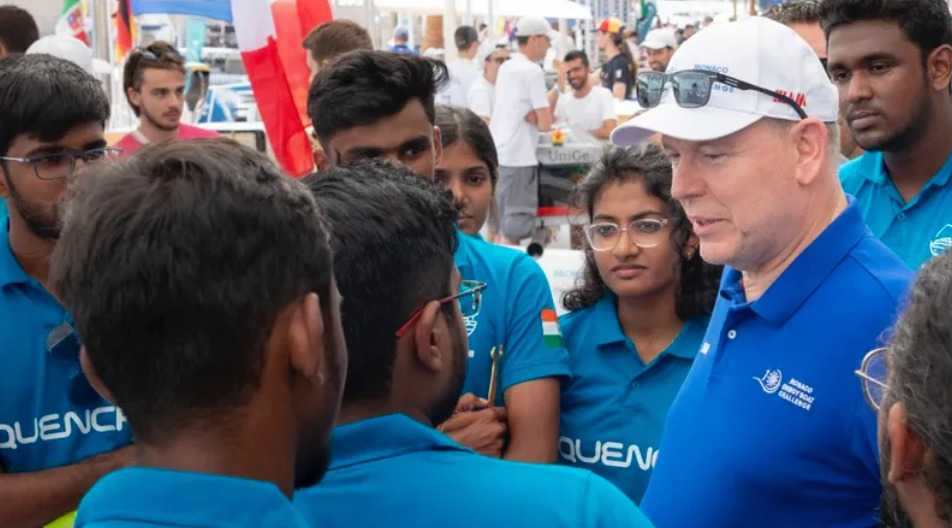
Another big supporter of the MEBC is HSH Prince Albert II of Monaco, who is President of the Yacht Club and also head of the Foundation Prince Albert II, dedicated to “the protection of the environment and the promotion of sustainable development on a global scale.” On opening day he was down at the paddocks, asking the university students about their various projects and wishing them good luck.
Less visible to the public but absolutely essential to the smooth running of the event is Charlotte Mille, Department Manager of Sport Events at the YCM – and her team. Tasked with coordinating universities and commercial boat builders from all over the world, along with the YCM E-Dock, Tech Talks, the Conference, Industry Pitches, Job Forums, the SeaLab featuring the IMOCA Yacht Explorer, the photographers, videographers and drone pilots who covered everything…for all of this to run so smoothly is an incredible accomplishment. Congratulations to Charlotte, Nina, Mia, Matthieu, Jeanne and so many more.
Indeed, so much happened at the MEBC that I will be breaking up the Plugboats coverage of it into three different posts to come over the next few days. This first will cover the Open Sea Class and commercial boats, the second will cover the Conferences, Round Tables and other presentations, and the third will cover the university teams and the Solar and Energy Class races.
Open Sea Class:
E-Rally, Maneuverability, Endurance and Speed Trials
The on-water events of the Monaco Energy Boat Challenge began in earnest on Thursday with the Parade, Qualifying Laps, Maneuverability Trials and YCM Speed Record, but on Wednesday there was a ‘warm up’. A fleet of commercial electric boats took part in an E-Rally, sponsored by Aqua superPower, that saw them travelling to Ventimiglia, Italy and back– a distance of about 32 nautical miles (60 km).
The E-Rally
Not every boat in the E-Rally took part in the formal competitions of the next few days, but there was definitely a spirit of rivalry at this friendly event when the boats took off from the open waters in front of the renowned Oceanographic Museum just outside Monaco’s Port Hercules.
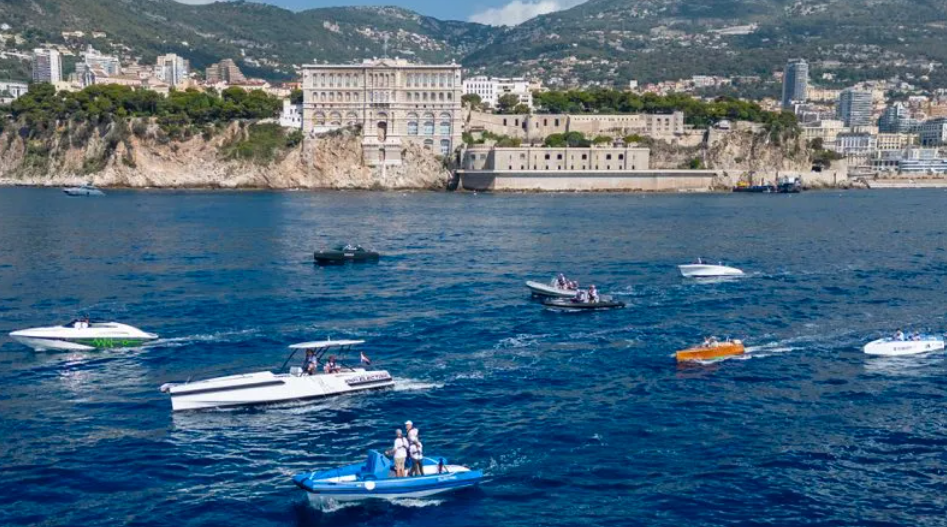
What a fantastic cross section of electric boats it was and a great demonstration of the variety of electric boats now available.
At the small end of the scale, there was the Futura by AS Labruna of Italy, one of the pioneers of Italy’s electric boating scene. In the mid 2000s CEO Massimo Labruna expanded the company– which was and is well known for agricultural motors and equipment – into the marine sector, and quickly started focusing on electric propulsion.
The Futura is just 1.65 meters long (5.5 feet), built in 1968 and restored and refitted in 2022 by shipwright Vito Saponaro of Monopoli, where AS Labruna is based. It was developed as a small model to demonstrate how hydrogen fuel cells can be used to increase range and autonomy for e-boats.
Small e-boats to large and everything in between
Massimo has now developed an entire division of AS Labruna – E-Vision – dedicated entirely to electric hydrogen and hybrid propulsion. A 5.7m /18.7 foot by that name was also part of the E-Rally flotilla. Its planing hull shows excellent stability, powered by three 11.5kW (≈20HP) outboard motors with 48V batteries, each storing 7 kiloWatt hours of energy.

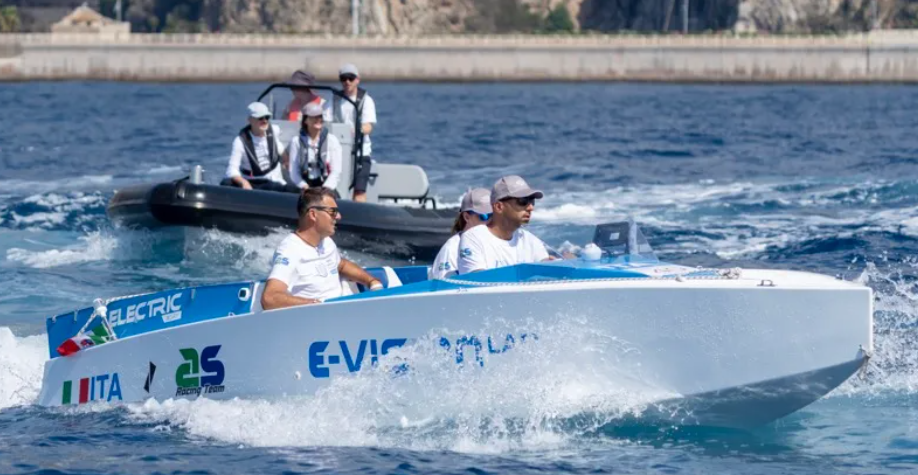
At the opposite end of the size and power spectrum was the new electric tender, fresh out of production, from VAMP Marine, an offshoot of the tenderworks yard of the Netherlands which designs and builds custom tenders.
This first VAMP model was created for a client who requested an all-electric tender to transport guests and exploring the local water when moored and wanted to assure it has enough speed and range to do the job. Coming in somewhere near 10 meters in length, it has twin 100kW motors and a large enough battery to enable about an hour’s worth of boating at top speed.

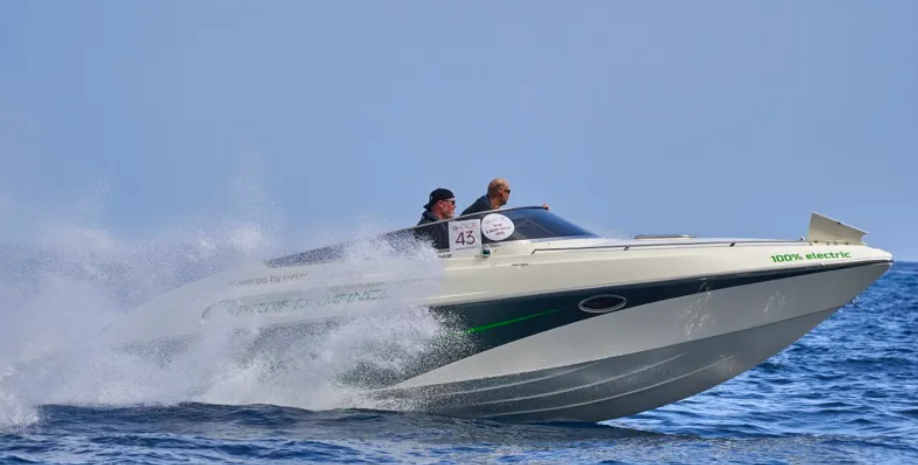
The Performance e801 had an even larger powertrain, the Evoy Hurricane 400+ (300 kw) liquid-cooled electric inboard motor linked to a Mercury Bravo One XR sterndrive. The day after the E-Rally, the Speed Record event was held on the site of the Yacht Club’s historic 1904 ‘kilometers course’ just outside the harbor. The Performance x Evoy 801 set a new record with a speed of 34.71 knots (64.22 km/h), eclipsing the mark set by the Vita Lion last year.
A record holder from another electric boat event was also in Monaco – outboard and inboard manufacturer e-dyn – the three time winner of the e-Regatta at the Venice Boat Show. In fact, there has never been any other champion in Venice than the e’dyn coupled with a hull by Kaiser. The Venice event was launched in 2021 and the Slovenian entry has been the overall winner – determined by total points from the e-Ballerina, Speed and Endurance event – each time.
Right next door to the e’dyn boat in the YCM E-Dock was another craft using the company’s 25kW outboard – but with an innovative new add-on: the Hydro Impulse impeller system. Above the water, the motor is identical to the e’dyn standard model. But underneath the waterline the gearing and propeller of the lower unit has been replaced with the Hydro Impulse, which was awarded Environment Achievement of the Year – Propulsion System Design at this year’s Electric & Hybrid Marine Expo.

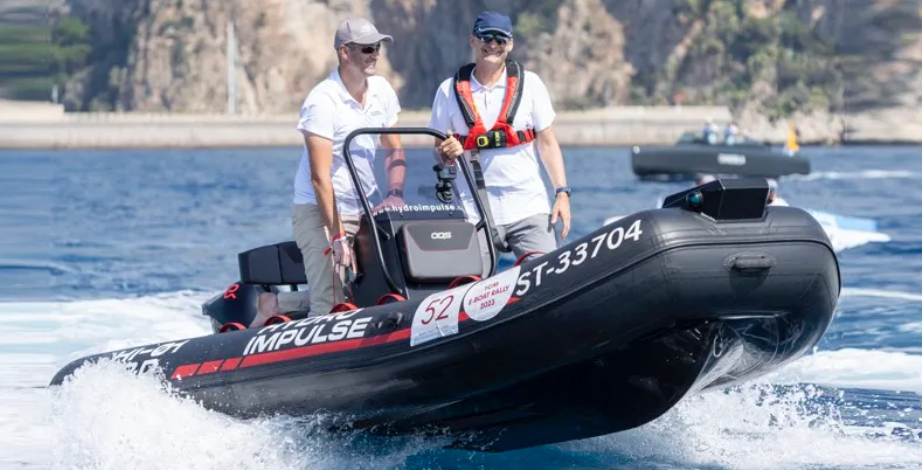
The HI’s impeller is driven by the shaft of the outboard, but because it is a jet/pump system surrounded by a cylindrical ‘tunnel’, significantly more of the motor’s powered is concentrated on thrust and moving the boat forward rather than dissipating energy to the sides, as happens with a propeller. Alois Bauer of Hydro Impulse told me this increases overall efficiency and range by as much as 30%. Plugboats will be writing more about this in the near future.
The e’dyn/Hydro Impulse setup was paired with a RIB hull, a particularly good match for electric motors because it requires less energy to plane than is required for a Vee hull, and less energy to maintain the plane because the inflated tubes help keep the boat on top of the water.
RIBs from RS Electric and Vita
RIBs are also very stable, which makes them adaptable to many different uses, as showcased by the boats from Vita and RS Electric Boats. The RS Electric Pulse 63, with integrated RAD40 electric motor, can be ordered in four different models: Coach Boat, Work Boat, Tender or everyday Leisure boat. The model that CEO Jon Partridge chose to bring to Monaco was the Coach set up, which, in addition to making the trip to Ventimiglia and competing in the Challenges, was also put to work when the Solar and Energy Class university events needed some extra help.


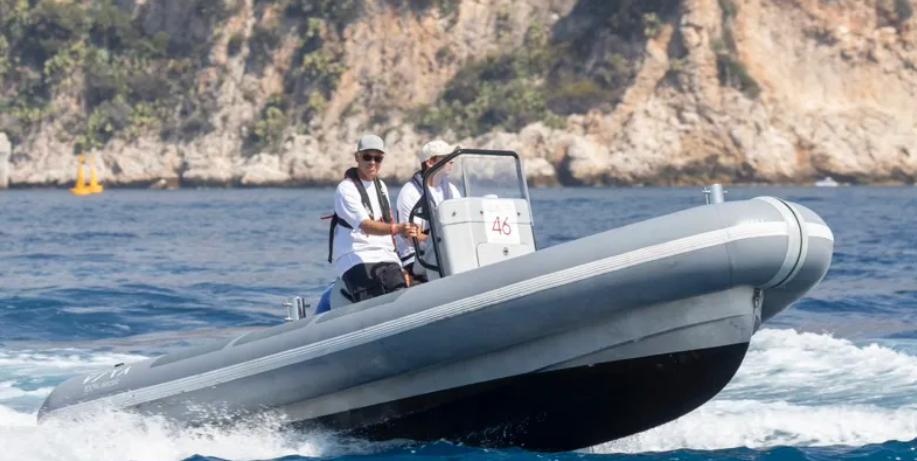
One of the four Vita RIBs at Monaco was the new Seadog model, which also helped out as required and demonstrated why this shorter option was added to the Vita line up. At 5.8 meters /19 ft (1.2 meters / 4 ft shorter than the Seal model), it has been designed specifically for use in marinas and ports. The larger Seal has the amenities that provide the comfort boaters want in a leisure craft, while the Seadog is stripped down and utilitarian.
They can both move, though. I was fortunate enough to be in the Seadog with Vita’s Clive Johnson and Fillippo Brignone when we were the first boat to arrive at Ventimiglia in Wednesday’s friendly E-Rally. In the next day’s official Speed Trial competition covering the same 16 NM route, the Seadog placed second and the Seal third.
Classics – new and refitted
Another e-speedster is the Riva El-Iseo, which was unveiled at the Yacht Club de Monaco last September in an event celebrating the 180th anniversary of the legendary boatyard. The 27 foot El-Iseo is the electrified version of the classic Riva Iseo, named for the lake where young shipwright Pietro Riva first started a small shop in 1842 to repair local fishing boats. It has a Parker GVM 310 all-electric motor with 409 kW peak power (557 HP) and a 150 kWh battery pack by Podium Advanced Technologies.
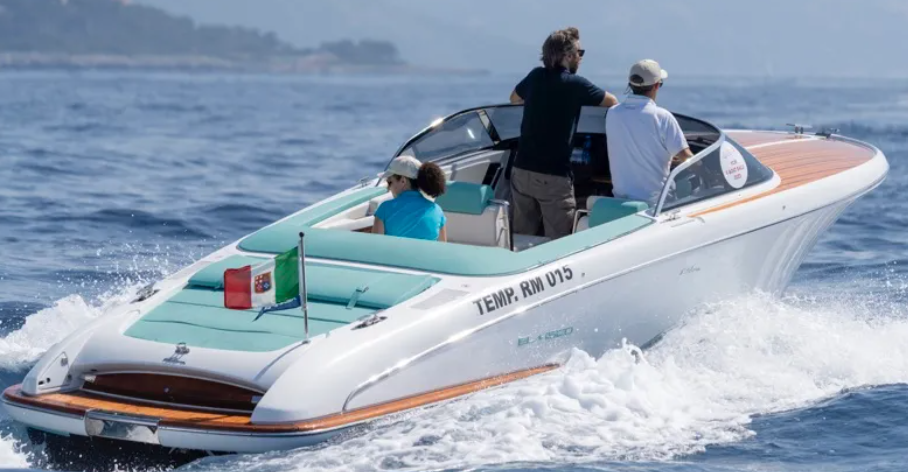
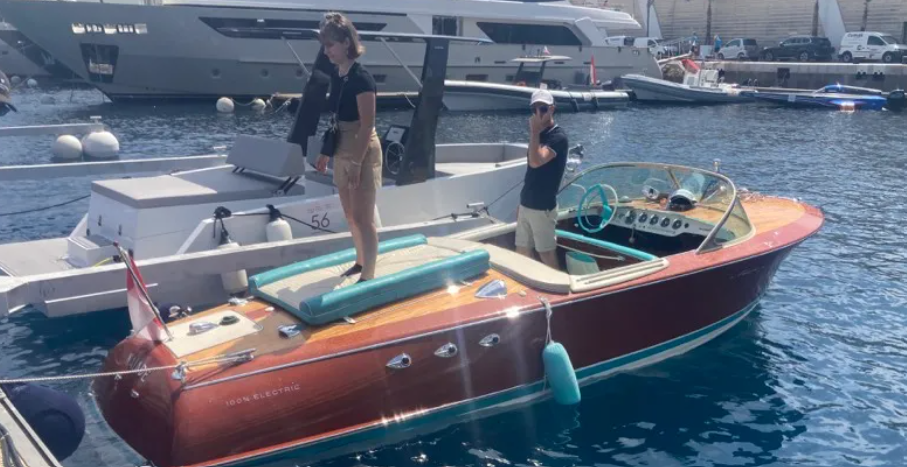
Then there was the 60s era Riva with an electric refit by François Richard and his team at Monaco-based Lanéva Boats. Lanéva has a line of retrofit kits and this Ariston woody has been meticulously redone with all the original parts retained – from the dashboard, to the throttle through the steering wheel. The only difference is that a 140 kW electric motor now powers this classic. Who knows what boats might be at next year’s MEBC – François mentioned he has two more retrofits underway including a vintage ChrisCraft.
A great addition to the Ventimiglia E-Rally was a delightful electric wooden boat with a charming basket weave outboard cowl cover. The refitter and owner of the boat is Comarbel – Compagnie Marseillaise des Bateaux Electricques – who rent the boat out for tours of the old Port of Marseille and trips to the Frioul Islands.
Completing the list of retrofits was SeaLab #3, from the Italy’s Sealence and Deepspeed. The vintage wooden boat usually plies the waters of Lake Como but also makes appearances at the Genoa Boat Show, Venice show and others. Sealence started in the electric boat world with the introduction of its electric hydrojet motor and now provides complete drive trains that include high powered liquid-cooled batteries from sister company E-DriveLab.
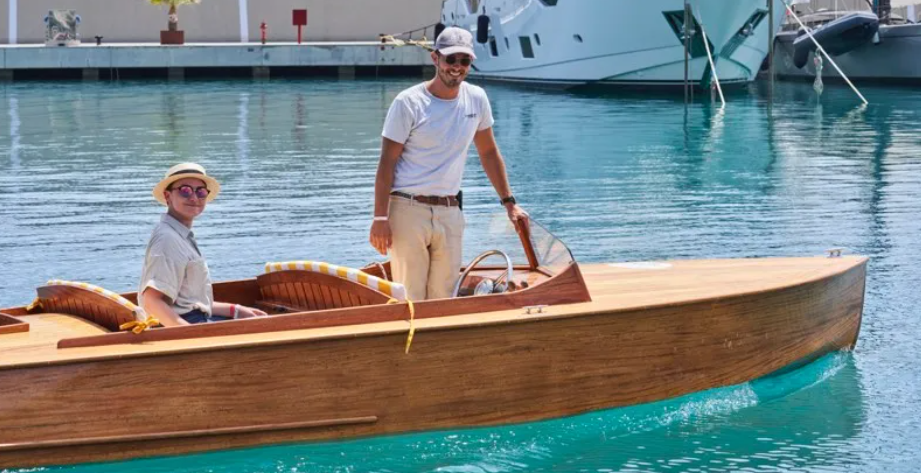

From Spain came the electric solar boat Lasai, which I first saw at Boot Dusseldorf this past winter. It was designed as an inland water or coastal cruising boat, perfect for a Monaco-Ventimiglia kind of daytrip, with plenty of room for passengers, a sunbed/diving platform at the stern and a solar-paneled roof to protect from the summer sun while providing electricity for the Torqeedo motors.
Those, then, are the boats that were in the water for the E-Rally. There was one, though, that flew above the water. Of course, I mean the Candela electric hydrofoiling boat, which also came from Marseilles courtesy of Bruno Delahaye and his Sud Plaisance dealership and rental charter service.
There is no doubt that the Candela makes head turns everywhere it goes, and Monaco is no exception. At the Prize Giving Ceremonies on Saturday night, the Jury presented the Candela 8 with its Coup de Couer Award – the French expression that roughly translates as ‘something that captures the heart’.
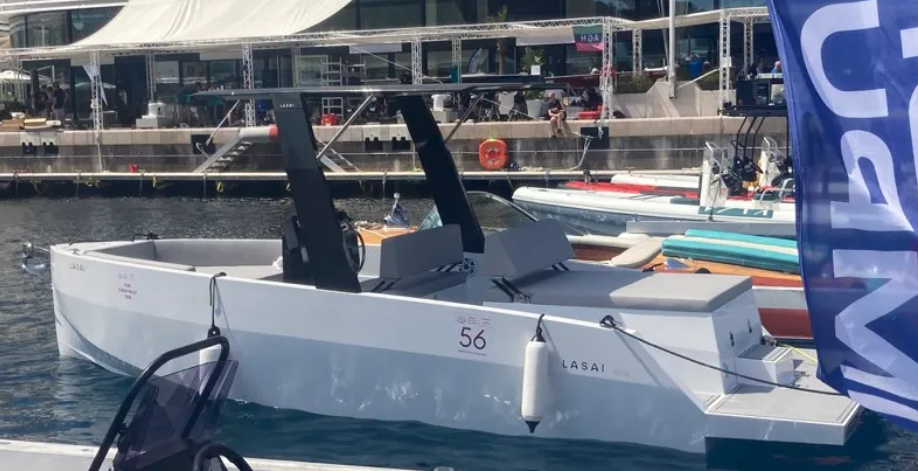

And now for the actual competitions!
The day after the Monaco-Ventimiglia E-Rally the Energy Boat Challenge began in earnest. The commercial boats at the MEBC are required to participate in three trials, with points awarded and then added up for the Overall Championship. If a team decides not to participate in an event, no points are awarded.
Maneuverability Trial
The three trials are the Maneuverability Trial, Endurance Trial and Speed Trial. In the Maneuverability Trial boats navigate a course of buoys within the harbor of the Yacht Club, with a maximum speed of 3 knots / 5.5 kmh. The winner must complete the course as outlined and the fastest time wins. RIBS took all three top spots.

Endurance Trial
The Endurance Trial is a 4 hour competition that had extra meaning in this year’s event as the participants were out on the open seas under a blazing sun in 32º C (89º F) temperatures. The Trial is designed to demonstrate the range/autonomy of electric boats, with the competitors completing as many 3 NM laps (5.5 km) in the time span.
While I have concentrated on the commercial electric boats in this article, any boat can join the Open Sea Class, and the winner of the Endurance Trial was a boat from TU Delft Hydro Motion, a team that began in solar boat racing in 2005.
For 15 years the team from the Technical University of Delft was one of the stars of solar boat races in the Netherlands and a top competitor in the Monaco Challenges. Made up of both students and alumni, they took a major step in 2021 in deciding to move away from pure solar-powered propulsion and explore the potential of hydrogen.
This year they built an entirely new boat – a hydrofoiling monohull that uses an electric motor powered by hydrogen fuel cells. The MEBC was the first test of the new vessel – and they definitely passed with flying colors (pun intended).

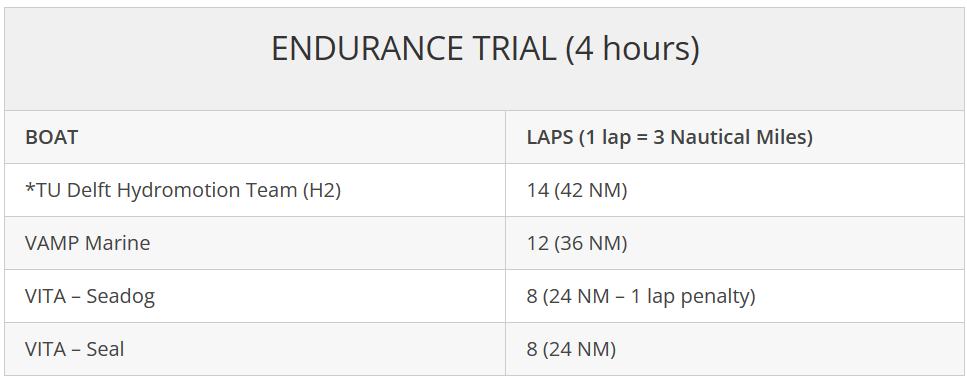
Speed Trial
Saturday, the final day of the Monaco Energy Boat Challenge, was the day for the long distance Speed Trial. There was a slight breeze on the morning of the event that grew throughout the day, creating challenging conditions. By the time the Trial was held, many of the smaller competitors had taken their boats out to test conditions in the open waters beyond the Club’s outer breakwater, the Quai Rainier III, and decided that the waves and wind presented too much of an obstacle.
In the end, only five boats competed: VAMP Marine, the two Vita Ribs, the Performance X Evoy 801 and the Riva El-Iseo.

Inspiration now and for the future
At the beginning of this article, I said that ‘inspiring’ is the word I would use to describe the Monaco Energy Boat Challenge and as I wrap it up, I think the word is even more accurate.
It was inspiring to see all the boats in the Open Seas Class – different sizes, different uses, different hull materials, different eras – and realize that every one of them is powered by electricity/hydrogen and not fossil fuels.
Even more inspiring were the snippets of conversation I overheard from members of the public who were attending the Challenge either out of curiosity, or because they knew one of the students participating. Almost every comment was a mixture of surprise that electric boats can do these things – and anticipation of them becoming more mainstream and readily available.
The most inspiring, though, was the activity in the paddocks with all of the students from around the world working on their boats, sharing knowledge, asking the commercial boat manufacturers about employment opportunities and talking with optimism about what they are doing now and what they are going to do for our waters and our world. The future is in good hands!